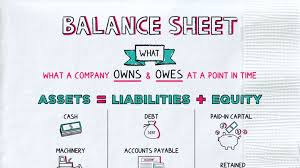The balance sheet is a critical financial statement that provides valuable insights into a company’s financial health. It offers a snapshot of a company’s assets, liabilities, and equity at a specific point in time, making it an essential tool for investors, creditors, and other stakeholders.
The importance of the balance sheet lies in its ability to provide an accurate picture of a company’s financial position. It enables investors to evaluate the performance of a company, assess its solvency and liquidity, and make informed decisions about investing in it. Creditors also rely on the balance sheet to determine the creditworthiness of a company and whether it can meet its financial obligations.
The balance sheet is divided into two sections, assets, and liabilities. The assets section lists everything that a company owns, including cash, property, equipment, and inventory. The liability section lists everything that a company owes, such as loans, accounts payable, and taxes.
Why Do We Need a Balance Sheet?
When the balance sheet is reviewed internally, it provides insight into the success and failure of a company. When it is reviewed externally, it provides insight into the available resources’ success. It also indicates the way in which they are financed.
Through the sheet, businesses and investors can equally benefit in the following manner:
- Businesses can identify areas of improvement so that their finances keep on thriving.
- Investors can decide whether a company is worth investing money in or not.
- Auditors can assess whether the company is in compliance with reporting guidelines and laws.
- Organizations can calculate important financial metrics, including liquidity, debt-to-equity ratio, and profitability.
Guidelines Followed
Balance sheets are mostly based on either of the two accounting guidelines: GAAP or IFRS. If your firm is in the U.S., you will have to create a balance sheet based on the GAAP guidelines. If your business is outside the U.S., then in most cases, you will follow IFRS guidelines.
In case, you are creating a GAAP-based sheet. In such a case, the company assets should be listed in descending order of their liquidity. High liquidity assets are above low liquidity assets. Also, current assets are placed above non-current assets.
The IFRS-based balance sheet reports assets in the increasing order of their liquidity. Assets with lower liquidity will be placed above assets with higher liquidity. That means non-current assets will be placed before current assets on the balance sheet.
Balance Sheet Format
Let us now go through the balance sheet in detail. Here, we are considering one of the sample balance sheet templates. The sheet is broadly divided into assets and liabilities. At the top, assets are listed and liabilities are listed at the bottom. The assets should be organized in order of their liquidity.
The order should be descending. This means that the higher liquidity assets should be on top whereas low liquidity assets should be placed below that. In the case of liabilities, the accounts are organized from short-term to long-term obligations. The final requirement from the sheet is that the total assets should be equal to the total liabilities. Then only, the sheet will be in balance.
Analyzing a Balance Sheet
To analyze the balance sheet, an analysis of financial ratios is also conducted by experts. Through the balance sheet, four main ratios can be determined. These include activity ratios, debt-to-equity, working capital, and financial strength ratios.
Through this analysis, experts can assess the operational efficiency of a company. They also help experts understand the company’s ability to meet its obligation and how it leverages them. Through in-depth analysis, investors can assess how the company finances itself and also if it is financially stable.



